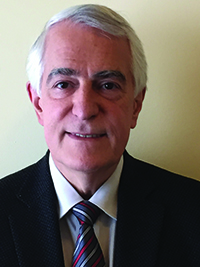Spring 2020 (Volume 30, Number 1)
Succession Planning and Transitions in Rheumatology:
My Experience
By Jacques P. Brown, MD, FRCPC
Download PDF

Retirement is a natural step in the professional life cycle, but it’s not the end of one’s personal life. In financial terms, early in my practice, like many of you, I had started contributing to a retirement savings plan to ensure adequate income for retirement. This long-term planning also applies to succession planning in a professional life.
As a research fellow of the Arthritis Society, I completed a two-year postdoctoral training in metabolic bone diseases at the Institut national de la Santé et de la Recherche Médicale (INSERM) unit directed by Professor Pierre J. Meunier in Lyon, France. Notwithstanding all the outstanding scientific knowledge that I received there, I also learned that everything could be done quite differently and still be well done! Early in my career, I had to leave my initial institution and, in doing so, I also learned that “nobody is irreplaceable.”
These two personal experiences have been instrumental in my approach to clinical and research work during my active professional life, as well as in my succession planning: you leave, and you will be replaced by someone who will do things differently . . . and very well!
In my case, the succession planning started soon after I became head of our rheumatology division (1996-2013), while our division was facing serious challenges in human resources. This happened when I was successfully developing my research activities. At that point, the two “lessons” came back to mind, thanks to my wife Claude, and I realized that I had to start looking for collaborators.
Collaborators are key to our success since you can’t have all the expertise needed in a single researcher, no matter how talented he or she is. More so, they do things differently and better.
In 2003, being highly involved as a Centre Director in the Canadian Multicentre Osteoporosis Study, I was looking for a collaborator in epidemiology to act as a Co-Director and help in developing and implementing another epidemiologic study on post-fracture care, ROCQ (Recognizing Osteoporosis and its Consequences in Quebec). This resulted in the return of an esteemed young researcher to our unit, Louis Bessette. Both studies provided unique epidemiological data on osteoporosis, defining fragility fractures, clinically meaningful vertebral fractures, morbidity and mortality, as well as financial costs associated with this debilitating disease. Later, Louis became an entrepreneurial partner in pharmaceutical clinical research, bringing his own expertise in inflammatory arthritides. Louis is now leading the team.
Another important contribution to research was the discovery in 2001, of the first and (still) only gene associated with Paget’s disease of bone on Chromosome 5q35 tel: sequestosome 1 (SQSTM1/p62). In 2007, this discovery favoured the establishment in our institution of a young researcher, Laëtitia Michou, who now leads our research program on the genetics of Paget’s disease of bone, atypical femoral fracture and rare genetic bone diseases.
Many other colleagues have or will contribute to my transition to retirement in June 2021. It is now time for me to get back to those who share my private life, my family.
Being a “bone head”, I did things differently, but I always felt respected by my rheumatology colleagues, and I feel privileged to be a CRA member.

Dr. Brown with his grandchildren.
Jacques P. Brown, MD, FRCPC
Clinical Professor of Medicine, Department of Medicine,
Laval University
Rheumatologist, CHU de Québec-Université Laval
Quebec City, Quebec
|
